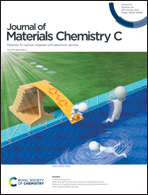Where is the best substitution position for amino groups on carbon dots: a computational strategy toward long-wavelength red emission†
Abstract
Carbon dots (CDs) are a promising fluorescent material in biological and optoelectronic applications owing to their high biocompatibility, low cytotoxicity, and high stability. Red emissive CDs are not only widely used in biological imaging due to their strong tissue penetration, but also improve the color rendering index of white LEDs. However, the structure–property relationship of CDs is still not clear, and red-emissive CDs are difficult to be fabricated in experiments. In this study, we reveal the relationship between charge transfer and the photoluminescence of amino-functionalized CDs using DFT and TDDFT calculations. It is found that the charge transfer has a clear correlation with the hole contribution of amino groups. Based on the study on the amino-substituted position, it is concluded that nucleophilic substitution positions are highly critical for obtaining CDs with long-wavelength red emission (LWRE-CDs), which can be prejudged via the calculation of the atomic charges. Moreover, the universality of these correlations is demonstrated in different systems composed of polycyclic aromatic hydrocarbons (i.e., anthracene, pyrene, tetracene, and phenanthrene) and electron-donating groups (i.e., –NH2, –N(CH3)2, –OH, –OCH3, and –CH3). This work provides a theoretical guidance for the preparation of high-performance LWRE-CDs.



 Please wait while we load your content...
Please wait while we load your content...